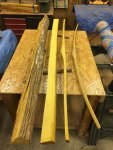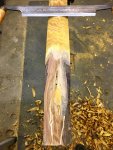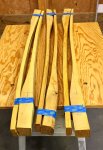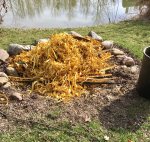You are using an out of date browser. It may not display this or other websites correctly.
You should upgrade or use an alternative browser.
You should upgrade or use an alternative browser.
Welcome to TheOhioOutdoors
Wanting to join the rest of our members? Login or sign up today!
Login / Join
Been busy in the shop
- Thread starter Jamie
- Start date
of all of the things that building wooden bows requires, attention to moisture content and how to dry wood for the specific purpose of making a bow is one that you will find the least amount of information on. nobody talks much about it. to quote my late friend and most influential mentor a first rate hunting bow is simply "...dry wood expertly tillered." and when you boil it all down, that is all it really is. a perfect example of the difference between simple and easy.
the idea is that as we go from live tree to finished bow we want moisture going in one direction the entire way. although it may seem counterintuitive, a green bow blank comes out of an 80 minute steam bath dryer than when it went in. steam is nothing more than a vehicle for the heat, and heat drives moisture from a blank that is likely still in the 25-30% MC range when we are working with freshly cut wood. we use wet heat on wet wood, dry heat on dry wood.
from left to right. chunky stave split, blank reduced to its width profile with back sealed, blank ready for correction, blank after correction. that blank is one that I'm tillering right now.

steam chamber is crude, but very effective. 4" galvanized duct pipe with a "T" connector wrapped in a Goodwill sleeping bag. the bottom of the "T" fits just perfectly into the camp coffee pot, which is where the steam comes from. heat source is an 1100 watt electric burner. the pipe slopes to the "T" from both ends so the condensed water vapor runs back into the pot instead of onto the floor. once there is steam rolling hard from both ends, the stave goes in for an hour or so.

I let this stave go a little longer to make sure it is heated through. Osage Orange responds exceedingly well to heat. the wood is so plasticized when it comes out of the steam tube that you could darn near bend it double. the stave gets strapped to the caul very quickly, placing clamps strategically to remove twist, humps, dips, and to align the crown of the stave. have to work fast so you get it clamped before it cools down too much.

it is not always necessary or required to steam staves to straighten them and such. some bow wood is just that perfect. for the other 99% of useable osage, it does tend to make for more reliable, better shooting finished self bows. simplifies tillering, too. most osage can benefit from a little coercion.
one down 5 to go.
the idea is that as we go from live tree to finished bow we want moisture going in one direction the entire way. although it may seem counterintuitive, a green bow blank comes out of an 80 minute steam bath dryer than when it went in. steam is nothing more than a vehicle for the heat, and heat drives moisture from a blank that is likely still in the 25-30% MC range when we are working with freshly cut wood. we use wet heat on wet wood, dry heat on dry wood.
from left to right. chunky stave split, blank reduced to its width profile with back sealed, blank ready for correction, blank after correction. that blank is one that I'm tillering right now.

steam chamber is crude, but very effective. 4" galvanized duct pipe with a "T" connector wrapped in a Goodwill sleeping bag. the bottom of the "T" fits just perfectly into the camp coffee pot, which is where the steam comes from. heat source is an 1100 watt electric burner. the pipe slopes to the "T" from both ends so the condensed water vapor runs back into the pot instead of onto the floor. once there is steam rolling hard from both ends, the stave goes in for an hour or so.

I let this stave go a little longer to make sure it is heated through. Osage Orange responds exceedingly well to heat. the wood is so plasticized when it comes out of the steam tube that you could darn near bend it double. the stave gets strapped to the caul very quickly, placing clamps strategically to remove twist, humps, dips, and to align the crown of the stave. have to work fast so you get it clamped before it cools down too much.

it is not always necessary or required to steam staves to straighten them and such. some bow wood is just that perfect. for the other 99% of useable osage, it does tend to make for more reliable, better shooting finished self bows. simplifies tillering, too. most osage can benefit from a little coercion.
one down 5 to go.
X2! I have a moisture meter for my pot calls. In between 6-6.5 is where I want to be for a call.Pretty cool stuff Jamie!
for osage bows, 7-9% is about where you want to be. much dryer than that and it starts to get brittle to do the work of bending, much wetter and wood takes too much set and will lack cast, i.e. the "wet noodle" effect. I do not own a moisture meter and don't really need one. listening to the tools on the wood and shavings under your feet can tell you plenty. still, properly dried wood is absolutely crucial to the function and longevity of wooden bows. if we don't get this right or don't know how the wood was treated before it came to us, bad things can happen, which is why I have always preferred to cut my own wood. I know exactly what I have.
Chad, is the mc in your calls critical because it affect the tone or for some other reason?
Chad, is the mc in your calls critical because it affect the tone or for some other reason?
Moisture is critical on calls because if it's too wet and dries out when the surface is glued in it will break the slate, glass, etc.for osage bows, 7-9% is about where you want to be. much dryer than that and it starts to get brittle to do the work of bending, much wetter and wood takes too much set and will lack cast, i.e. the "wet noodle" effect. I do not own a moisture meter and don't really need one. listening to the tools on the wood and shavings under your feet can tell you plenty. still, properly dried wood is absolutely crucial to the function and longevity of wooden bows. if we don't get this right or don't know how the wood was treated before it came to us, bad things can happen, which is why I have always preferred to cut my own wood. I know exactly what I have.
Chad, is the mc in your calls critical because it affect the tone or for some other reason?
Whoa!!!! What a great writeup since I last checked in Jamie. This is very interesting and looking forward to following along to the end.
while knifing the last of the osage I'm working on I uncovered these.


these are wood wasp larvae, but I don't know the specie. these borers can wreak havoc on bow wood that is laying around for any length of time. when I have had to leave after cutting I have treated logs with diazinon or malathion in the past, and those both keep everything off of them, but I didn't have any, so I used Permethrin, which apparently didn't keep the wasps away. usually they only inhabit the softer sapwood, but sometimes their wandering takes them into heartwood, which in some cases turns bow wood into firewood. didn't matter on these as I had to dig through 14 growth rings to get to the one I wanted, about an inch of material. I usually don't dig that far for a bow's back, but I had to make some concessions with this log. One split I cut up into firewood because the rings were too thin and the ratio of early wood to late wood was awful. the two others I cut one billet out of each, sacrificing the remainder to the fire wood pile. so, I wound up with three full length staves and a pair of billets. I had to dig really deep into both billets, but I think It'll be worth it.


these are wood wasp larvae, but I don't know the specie. these borers can wreak havoc on bow wood that is laying around for any length of time. when I have had to leave after cutting I have treated logs with diazinon or malathion in the past, and those both keep everything off of them, but I didn't have any, so I used Permethrin, which apparently didn't keep the wasps away. usually they only inhabit the softer sapwood, but sometimes their wandering takes them into heartwood, which in some cases turns bow wood into firewood. didn't matter on these as I had to dig through 14 growth rings to get to the one I wanted, about an inch of material. I usually don't dig that far for a bow's back, but I had to make some concessions with this log. One split I cut up into firewood because the rings were too thin and the ratio of early wood to late wood was awful. the two others I cut one billet out of each, sacrificing the remainder to the fire wood pile. so, I wound up with three full length staves and a pair of billets. I had to dig really deep into both billets, but I think It'll be worth it.
one thing is for certain, when you are liberating bow staves from osage orange trees there is considerable waste most times. Since osage has the highest BTU rating of any north American hardwood, burning nearly half as hot as coal, "waste" is a poor word choice.
out of one full length section and one 40" section for billets, I got three full length staves, three pairs of sister billets and one pair of first cousin billets, some nice pieces of firewood and kindling, and a giant pile of shavings, which is now a pile of ashes.




now that all of this wood has been reduced to blanks(single growth ring for the back established, sealed with shellac on the back and ends reduced to approximately 2" width, and rough thickness taper) these sweethearts will be air dried inside my shop, out of the wind, sun, rain in a semi climate controlled environment for a minimum of a about two months, until they are in equilibrium with the Ohio climate which is a 15% mc, at which point we could introduce them to the hot box and begin force-drying at 70-75 degrees and very low humidity for a few more weeks, and begin to reduce the blanks to actual bows with tillering and final shaping. these will be resting peacefully in the shop for much longer than that as I have several other staves to work on, some of which I cut clear back in 1996. I have some work to do, but it's a labor of love. bowyers' work is never done, lol.
out of one full length section and one 40" section for billets, I got three full length staves, three pairs of sister billets and one pair of first cousin billets, some nice pieces of firewood and kindling, and a giant pile of shavings, which is now a pile of ashes.




now that all of this wood has been reduced to blanks(single growth ring for the back established, sealed with shellac on the back and ends reduced to approximately 2" width, and rough thickness taper) these sweethearts will be air dried inside my shop, out of the wind, sun, rain in a semi climate controlled environment for a minimum of a about two months, until they are in equilibrium with the Ohio climate which is a 15% mc, at which point we could introduce them to the hot box and begin force-drying at 70-75 degrees and very low humidity for a few more weeks, and begin to reduce the blanks to actual bows with tillering and final shaping. these will be resting peacefully in the shop for much longer than that as I have several other staves to work on, some of which I cut clear back in 1996. I have some work to do, but it's a labor of love. bowyers' work is never done, lol.
Really enjoyed catching back up with you here. It sucks losing so much wood due to bugs but it is what it is I guess. This is one of my most favorite threads I’ve read EVER!
didn't really lose any wood to bugs this wood, have not lost much ever, really. It does happen, though. This is never a concern once the bark and sapwood are removed as this is where those wasp larvae and even a powder post beetle sometimes will be dining. there is not bug on earth badass enough to gnaw on osage heartwood!
glad you are enjoying it. is it the subject matter or my mad writin' skeels that keeps you coming back?
glad you are enjoying it. is it the subject matter or my mad writin' skeels that keeps you coming back?
hoot gibson
The Crew
hoot gibson
The Crew
hell yes . put some kind of parental block on the computer . but at least the strength in my right arm has gotten better . I'm shooting 145 lbs now .
hell yes . put some kind of parental block on the computer . but at least the strength in my right arm has gotten better . I'm shooting 145 lbs now .
LMAO Hoot! You must delete the history Hoot, that’s what I have heard...
hoot gibson
The Crew
so as I'm wrapping this selfbow stave preparation up and cleaning up the mess in the shop I remembered I sat these aside instead of adding to the kindling pile. some of the splits were large enough that when I cut them to their 2" width, I got some pretty chunky scraps from the band saw. I'll use these for the risers on bamboo backed osage bows. having one thick piece to fill out the handle is very much desirable over gluing up two or three smaller scraps to get to 1 1/4" thickness that is needed. Usually these only come from the one thick board that a band saw mill cannot cut down any further, and they are usually 8/4 or so. and that is only if we cannot rip usable board stock from it because of wind shakes or other damage. heavy stock like this is rather rare and not always easy to come by when cutting bow wood. I usually cut these riser blocks to 1 1/2" X 1 1/4" when I have the stock to do it, but some of these are not quite an inch and a half wide. still, these will make 7 excellent clean, quarter sawn handles. waste not, want not sayeth the frugal bowyer. 




Milo
Tatonka guide.
- 8,189
- 171
I’m going to get some logs cut up here soon and will give you some for handles. I wll probably be cutting them 2-1/8 a 2-1/4 . I will bring them over, drink your beer and steal some sausage and leave you a pile of riser blocksso as I'm wrapping this selfbow stave preparation up and cleaning up the mess in the shop I remembered I sat these aside instead of adding to the kindling pile. some of the splits were large enough that when I cut them to their 2" width, I got some pretty chunky scraps from the band saw. I'll use these for the risers on bamboo backed osage bows. having one thick piece to fill out the handle is very much desirable over gluing up two or three smaller scraps to get to 1 1/4" thickness that is needed. Usually these only come from the one thick board that a band saw mill cannot cut down any further, and they are usually 8/4 or so. and that is only if we cannot rip usable board stock from it because of wind shakes or other damage. heavy stock like this is rather rare and not always easy to come by when cutting bow wood. I usually cut these riser blocks to 1 1/2" X 1 1/4" when I have the stock to do it, but some of these are not quite an inch and a half wide. still, these will make 7 excellent clean, quarter sawn handles. waste not, want not sayeth the frugal bowyer.
View attachment 59866View attachment 59867
